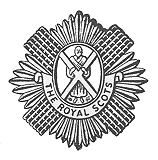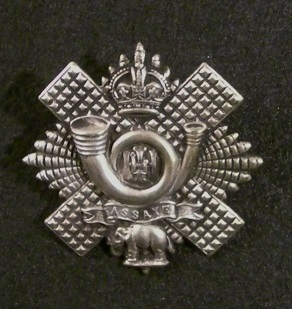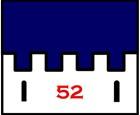Origins
The Scottish Border Brigade (originally the South of Scotland Brigade) was a Volunteer Infantry Brigade of the British Army formed in 1888.
The enthusiasm for the Volunteer movement following an invasion scare in 1859 saw the creation of many Rifle, Artillery and Engineer Volunteer units composed of part-time soldiers eager to supplement the Regular British Army in time of need. [1] [2] The Stanhope Memorandum of 1888 proposed a comprehensive Mobilisation Scheme for Volunteer units, which would assemble in their own brigades at key points in case of war. In peacetime, these brigades provided a structure for collective training. [3] [4] Under this scheme the Volunteer Battalions in the Scottish Border areas would assemble at Hawick. [5]
From 1888, the South of Scotland/Scottish Border Brigade had the following composition: [5]
- 1st Roxburgh and Selkirk (The Border) Rifle Volunteer Corps, with the 1st Roxburgh Mounted Rifles Volunteers attached, at Newtown St Boswells
- 2nd (Berwickshire) Volunteer Battalion, Kings Own Scottish Borderers, at Duns
- 3rd (Dumfries) Volunteer Battalion, Kings Own Scottish Borderers, at Dumfries
- Galloway Volunteer Rifle Corps at Castle Douglas
- 2nd (Angus) Volunteer Battalion, The Royal Highlanders (Black Watch), at Arbroath
- 5th (Perthshire) Volunteer Battalion, The Royal Highlanders (Black Watch), at Birnham
- Supply Detachment, Army Service Corps
- Bearer Company, Army Hospital Corps (later Royal Army Medical Corps)
In the early 1890s, the two Black Watch battalions were replaced by:
After a further reorganisation in 1902, the 1st and 2nd VBs of the Royal Scots Fusiliers (at Kilmarnock and Ayr respectively) replaced the two battalions of the Royal Scots.
The Brigade Headquarters (HQ) and place of assembly was at Hawick and Colonel Viscount Melgund (later 4th Earl of Minto) was appointed brigade commander on 11 July 1888. From 1900, the brigade commander was the Officer Commanding the 25th Regimental District (the KOSB district) at Berwick-upon-Tweed, then from 1906 it was commanded by retired Colonel P.D. Trotter. [5]
Between the wars
After the war, the brigade and division were both disbanded as was the Territorial Force. The Territorial Force was, however, reformed in 1920 as the Territorial Army and the 52nd Division was reconstituted as was the brigade, which was redesignated as the 155th (South Scottish) Infantry Brigade. The brigade was reformed with the same units as it had before the First World War. [17]
In 1921, the 4th and 5th battalions of the Royal Scots Fusiliers were amalgamated into the 4th/5th Battalion, Royal Scots Fusiliers [18] and it was later transferred to the 156th (Scottish Rifles) Infantry Brigade, later redesignated 156th (West Scottish) Infantry Brigade. The 155th Brigade later received the 4th/5th (Queen's Edinburgh Rifles) Battalion, Royal Scots (the amalgamated 4th and 5th battalions) and the 7th/9th (Highlanders) Battalion, Royal Scots (the amalgamated 7th and 9th) both arrived from 156th Brigade and was redesignated 155th (East Scottish) Infantry Brigade.
In the late 1930s, there was an increasing need for anti-aircraft defences throughout Britain and many infantry battalions were converted into anti-aircraft or searchlight units of the Royal Artillery or Royal Engineers. In 1938, all infantry brigades of the British Army were reduced from four to three battalions and, in the same year, the 4th/5th Battalion, Royal Scots was converted into an anti-aircraft role, becoming the 4th/5th Battalion, Royal Scots (52nd Searchlight Regiment). [19] In 1939 the brigade was finally redesignated 155th Infantry Brigade.

The 52nd (Lowland) Infantry Division was an infantry division of the British Army that was originally formed as the Lowland Division, in 1908 as part of the Territorial Force. It later became the 52nd (Lowland) Division in 1915. The 52nd (Lowland) Division fought in the First World War before being disbanded, with the rest of the Territorial Force, in 1920.

The Royal Scots, once known as the Royal Regiment of Foot, was the oldest and most senior infantry regiment of the line of the British Army, having been raised in 1633 during the reign of Charles I. The regiment existed continuously until 2006, when it amalgamated with the King's Own Scottish Borderers to become the Royal Scots Borderers, which merged with the Royal Highland Fusiliers, the Black Watch, the Highlanders and the Argyll and Sutherland Highlanders to form the Royal Regiment of Scotland.
The 2003 Defence White Paper, titled Delivering Security in a Changing World, set out the future structure of the British military, and was preceded by the 1998 Strategic Defence Review (SDR) and the 2002 SDR New Chapter, which responded to the immediate challenges to security in the aftermath of the September 11 attacks in 2001. Published under the then Secretary of State for Defence, Geoff Hoon, the report effectively introduced a series of cutbacks to core equipment and manpower and the scaling back of a series of future capital procurement projects. This was justified due to the implementation of a policy termed Network Enabled Capability. The review also outlined a major restructuring and consolidation of British Army Infantry regiments.

The King's Own Scottish Borderers (KOSBs) was a line infantry regiment of the British Army, part of the Scottish Division. On 28 March 2006 the regiment was amalgamated with the Royal Scots, the Royal Highland Fusiliers, the Black Watch, the Highlanders, the Argyll and Sutherland Highlanders, 52nd Lowland Regiment, and 51st Highland Regiment to form the Royal Regiment of Scotland. However, after just a few months the battalion merged with the Royal Scots Battalion to form the Royal Scots Borderers.

The Royal Scots Fusiliers was a line infantry regiment of the British Army that existed from 1678 until 1959 when it was amalgamated with the Highland Light Infantry to form the Royal Highland Fusiliers which was later itself merged with the Royal Scots, King's Own Scottish Borderers, the Black Watch, the Argyll and Sutherland Highlanders and the Highlanders to form a new large regiment, the Royal Regiment of Scotland.

The Highland Light Infantry (HLI) was a light infantry regiment of the British Army formed in 1881. It took part in the First and Second World Wars, until it was amalgamated with the Royal Scots Fusiliers in 1959 to form the Royal Highland Fusiliers which later merged with the Royal Scots Borderers, the Black Watch, the Highlanders and the Argyll and Sutherland Highlanders to form the Royal Regiment of Scotland, becoming the 2nd Battalion of the new regiment.

The 52nd Lowland Volunteers is a battalion in the British Army's Army Reserve or reserve force in the Scottish Lowlands, forming the 6th Battalion of the Royal Regiment of Scotland, also known as 6 SCOTS. Due to its erstwhile association with the 1st Regiment of Foot, it is the senior Reserve line infantry battalion in the British Army. It is one of two Reserve battalions in the Royal Regiment of Scotland, along with 51st Highland, a similar unit located in the Scottish Highlands.
The Lowland Brigade is a historical unit of the British Army which has been formed a number of times. It is traditionally Scottish as the name derives from the Scottish Lowlands.

The 56th Infantry Brigade was an infantry brigade of the British Army that saw active service in both the First and the Second World Wars.

The Royal Regiment of Scotland is the senior and only Scottish line infantry regiment of the British Army Infantry. It consists of three regular and two reserve battalions, plus an incremental company, each formerly an individual regiment. However, three regular battalions maintain their former regimental pipes and drums to carry on the traditions of their antecedent regiments.

The 27th Infantry Brigade was an infantry brigade of the British Army that saw service in the First World War, the Second World War, and the Korean War. In Korea, the brigade was known as 27th British Commonwealth Brigade due to the addition of Canadian, Australian, New Zealand and Indian units.

The 29th Infantry Brigade was an infantry brigade unit of the British Army. It was originally raised in 1914 and saw service during the First and Second World Wars and the Korean War.

The 52nd Infantry Brigade was a formation of the British Army, which was first formed in 1914 as part of Kitchener's Army. The brigade was disbanded in 1919, but reformed in British India during the Second World War and disbanded in 1945. It was again formed in 1982, and existed until 2010.
The 158th Infantry Brigade was an infantry brigade of the British Army that served in both the First and Second World Wars, before being disbanded in 1968. Throughout its existence the brigade was assigned to the 53rd (Welsh) Infantry Division and was composed almost entirely of Territorial battalions from the Royal Welch Fusiliers.
Major General Sir Edmund Hakewill-Smith, was a senior British Army officer who served in both the First and Second World Wars.
The 156th Brigade was an infantry brigade formation of the British Army. The brigade saw active service in both the First and the Second World Wars with the 52nd (Lowland) Infantry Division.
The 157th Brigade was an infantry brigade of the British Army. The brigade fought in both the First and the Second World Wars, assigned to 52nd (Lowland) Infantry Division.
The 65th Division of the British Army was a second-line Territorial Force division, formed in 1914, which served on home defence duties during the First World War.
221st Mixed Brigade was a Scottish Home Service formation of the British Army that served under various titles throughout World War I.
The 194th Brigade was an infantry brigade of the British Army, raised during World War I. The brigade was part of the Territorial Force and formed as a 2nd Line duplicate of the 155th Brigade. Assigned to the 65th Division, the brigade remained in the United Kingdom throughout the war.










